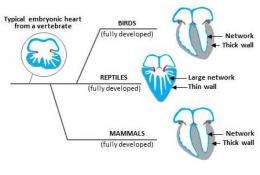Researchers find our inner reptile hearts

An elaborate system of leads spreads across our hearts. These leads – the heart's electrical system – control our pulse and coordinate contraction of the heart chambers. While the structure of the human heart has been known for a long time, the evolutionary origin of our conduction system has nevertheless remained a mystery. Researchers have finally succeeded in showing that the spongy tissue in reptile hearts is the forerunner of the complex hearts of both birds and mammals. The new knowledge provides a deeper understanding of the complex conductive tissue of the human heart, which is of key importance in many heart conditions.
"The heart of a bird or a mammal – for example a human – pumps frequently and rapidly. This is only possible because it has electrically conductive tissue that controls the heart. Until now, however, we haven't been able to find conductive tissue in our common reptilian ancestors, which means we haven't been able to understand how this enormously important system emerged," says Bjarke Jensen, Department of Bioscience, Aarhus University. Along with Danish colleagues and colleagues from the University of Amsterdam, he can now reveal that the genetic building blocks for highly developed conductive tissue are actually hidden behind the thin wall in the spongy hearts of reptiles. The new results have just been published in the journal PLoS ONE.
"We studied the hearts of cold-blooded animals like lizards, frogs and zebrafish, and we investigated the gene that determines which parts of the heart are responsible for conducting the activating current. By comparing adult hearts from reptiles with embryonic hearts from birds and mammals, we discovered a common molecular structure that's hidden by the anatomical differences," explains Dr Jensen.
Since the early 1900s, scientists have been wondering how birds and mammals could have developed almost identical conduction systems independently of each other when their common ancestor was a cold-blooded reptile with a sponge-like inner heart that has virtually no conduction bundles.
The studies show that it is simply the spongy inner tissue in the foetal heart that gets stretched out to become a fine network of conductive tissue in adult birds and mammals. And this knowledge can be put to use in the future.
"Our knowledge about the reptilian heart and the evolutionary background to our conductive tissue can provide us with a better understanding of how the heart works in the early months of foetal life in humans, when many women miscarry, and where heart disorders are thought to be the leading cause of spontaneous abortion," says Professor Tobias Wang.
More information: www.plosone.org/article/info%3Adoi%2F10.1371%2Fjournal.pone.0044231
Journal information: PLoS ONE
Provided by Aarhus University


















